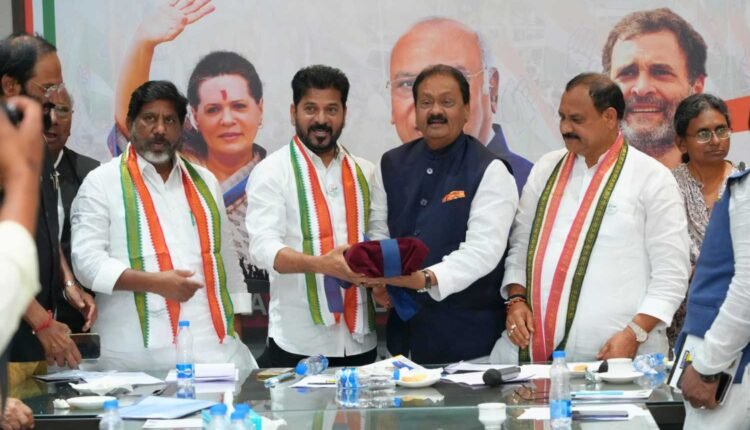Hyderabad: Chief Minister A. Revanth Reddy launched “Loyalty & Legacy: 45 Years with Congress Party” at Gandhi Bhavan after the TPCC Political Affairs Committee meeting on Saturday night. The publication documents the career of Mohammed Ali Shabbir, a senior Congress leader and Advisor to the Telangana Government, and positions his work within the party’s social justice agenda.
The dais featured Deputy CM Mallu Bhatti Vikramarka, AICC Telangana incharge Meenakshi Natarajan, TPCC President B. Mahesh Kumar Goud, and several ministers and veterans. The attendees included Uttam Kumar Reddy, Damodar Raja Narsimha, Komatireddy Venkat Reddy, Jupally Krishna Rao, Ponguleti Srinivas Reddy, Adluri Lakshman Kumar, Konda Surekha, D. Seethakka, G. Vivek, Vakiti Srihari, V. Hanumantha Rao, K. Jana Reddy, Dr. J. Geetha Reddy, Dr. K. Keshav Rao, Balram Naik, and Anjan Kumar Yadav.
The book starts with Mohammed Ali Shabbir’s early work as a Youth Congress and NSUI activist inspired by Indira Gandhi. It records the 1980 Kamareddy campaign for Indira Gandhi, who later won the Medak seat and returned as Prime Minister. It then follows his party roles across decades, noting a pattern of organisational duty in both government and opposition.
The Policy Spine Of Mohammed Ali Shabbir’s Career
The analysis foregrounds a sequence of policy steps. In 1993, as minister in the 1989–94 period, he created India’s first Minority Welfare Department. He brought the Waqf Board, Urdu Academy, Haj Committee, and Minorities Finance Corporation under one administrative unit. The government earmarked Rs. 2 crore for minorities in 1993–94. On August 25, 1994, GO MS No. 30 proposed reservations for 14 backward castes, including Muslims, Kapus, Telagas, and Balijas. The order stalled because Congress lost power the same year and the Puttuswamy Commission did not file its report even after extensions. The book frames the GO as a starting node for a wider social justice debate.
The second ministerial term, 2004–09, came under Dr. Y. S. Rajasekhara Reddy. Within weeks of taking office, the government granted 5% reservation for Muslims, later revised to 4% after judicial review. The book counts over 20 lakh students and job aspirants as beneficiaries across Andhra Pradesh and Telangana. Additionally, the tenure added English medium residential schools and junior colleges for minorities, expanded scholarships and hostels, and launched mass marriages for poor Muslim girls, now known as Shaadi Mubarak. As NRI Affairs Minister, Mohammed Ali Shabbir prioritised repatriation for stranded Gulf workers and opened an attestation centre to reduce procedural delays.
The chapters on opposition years place him in the Telangana Legislative Council as Leader of Opposition. He questioned the BRS government led by K. Chandrashekhar Rao on minority welfare delivery, farmer distress, and governance. The editors argue that sustained floor interventions can keep a reduced party visible and relevant. In that reading, committee work and debate time operate as instruments of organisational survival.

The book also covers political pressures he faced. He protested remarks made by a TDP minister about Rajiv Gandhi and went to jail. He faced ED questioning in a case concerning Sonia Gandhi and Rahul Gandhi. In 1997, he survived a Naxalite attack in Machareddy while unveiling statues of Indira and Rajiv Gandhi. Five party workers died. The editors treat these incidents as tests of risk appetite that shape political identities.
Recruitment attempts by rivals appear repeatedly. The TDP and later the BRS offered positions, including cabinet berths. He stayed with Congress. The ledger shows 28 years in opposition out of 45. The persistence becomes a focal point of the book’s title – loyalty and legacy – tied directly to Mohammed Ali Shabbir’s choices in difficult cycles.
K. Jana Reddy’s preface situates the career in institutional memory. He writes of serving with Mohammed Ali Shabbir as cabinet colleagues and, later, as Leaders of Opposition in different Houses. The foreword suggests that character explains longevity. At the launch, CM Revanth Reddy described him as a pillar of Telangana Congress and linked his legacy to the 4% reservation that continues to shape educational and job access.
Consequently, the book functions both as a biography and as an index of policy milestones. It records institutional design in the early 1990s, the reservation track of the 2000s, and the opposition strategy after Telangana’s formation. In doing so, it preserves a segment of Congress organisational history anchored in Mohammed Ali Shabbir’s work.

